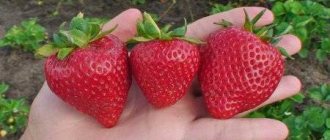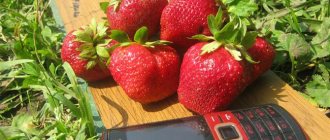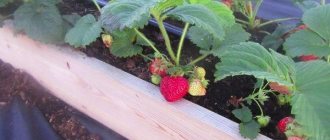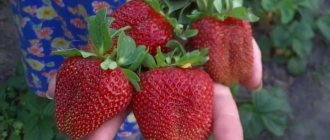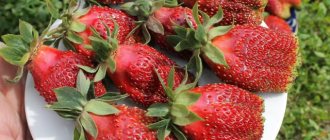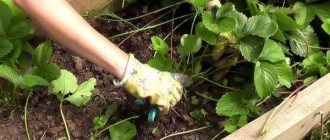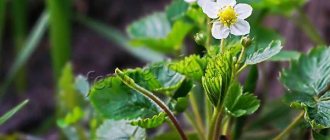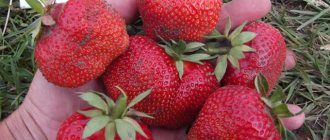Home / Garden / Berries
Back
Published: 07/04/2020
0
Rate this post
In the ranking of mid-late crop varieties, Arosa strawberry occupies a leading position. It is valued for its large fruit, voluminous harvest and excellent taste, which are not characteristic of many late varieties. In order for all the listed benefits to be realized, and for the description of the variety to correspond to reality, it is important to plant the plants correctly and properly care for them.
- 1 Description of the berry crop
- 2 Advantages and disadvantages
- 3 Features of planting and growing
- 4 Reviews from summer residents
Breeding history
The Arosa variety was developed by the Italian company CIV, which is engaged in developing new varieties of berries for continental and Mediterranean climates. The company is famous for crossing varieties with the best characteristics with each other, obtaining a new species with “ideal” individual characteristics.
Arosa was obtained by combining the qualities of the Marmolada variety and the American Chandler strawberry. It is thanks to the crossing of these species that Arosa received such high rates of resistance to disease and temperature conditions.
Did you know? 100 g of fresh strawberries contain 99% of the daily value of vitamin C.
Origin and registration
Strawberry "Arosa" was bred by specialists of the Consortium of Italian Nurseries within the framework of the CIV (Centro Innovazione Varietale) breeding program, obtained by crossing the popular varieties "Marmolada Onebor" and "Chandler".
Planting material of imported and domestic production is sold by many domestic nurseries and agricultural companies
The variety is patented in Europe: the licensing rights for its distribution belong to Italian nurseries (in particular, “Salvi”, etc.); is not included in the State Register of the Russian Federation; in 2008 it was officially registered in the plant register of Ukraine as approved for cultivation in the forest-steppe zone.
"Arosa" is adapted to the continental climate and is suitable for cultivation in open ground in the middle zone and southern regions of Russia, almost throughout the entire territory of Ukraine and Belarus. It reveals its productivity potential well in greenhouse conditions, greenhouses, tunnels, including when cultivated “without soil” (using peat bag technologies, hydroponics).
The variety is suitable for both open ground and greenhouse cultivation, where it shows good results in peat bags or hydroponics
Description and characteristics of culture
Despite the fact that most strawberry varieties are very similar to each other and, at first glance, it is very difficult to distinguish them, Arosa has a number of external characteristics that are characteristic only of this variety.
Kusta
An adult bush is of medium size and widely “scatters” its leaves. The leaves themselves have a light green tint, the plate is slightly wrinkled and has light fluff around the edges. The petioles are also fluffy. The bush grows and forms very quickly.
The peduncle is located above the leaves. The flower itself is large white, cup-shaped. The antennae are medium in size, however, quite capable of rapid reproduction. One bush forms about 10 inflorescences.
Yagod
Arosa berries are large (20–30 g), juicy, sweet. They have a cone-shaped shape (typical of most varieties of strawberries). Color can vary from orange-scarlet to red. The seeds on the berries are slightly pressed, they are clearly visible and easy to separate from the elastic, shiny surface.
Description of the variety
Bushes
Arosa bushes are not large in size and are quite compact. The rosette of leaves is moderately spreading, the leaves themselves are medium-sized, light green in color and slightly pubescent, like the petioles on which they are located.
The inflorescences are slightly raised above the leaves, they are distinguished by their large size and the even shape of the corolla.
Arosa forms an average number of tendrils, reproduces well, but does not produce dense plantings. The bush grows quickly, actively gaining strength and green mass during the first season.
Berries
Arosa fruits are different:
- orange-red color;
- pleasant aroma;
- juiciness and density;
- good keeping quality and transportability;
- average weight 40 g;
- seeds located at the same level with the pulp;
- white tips at the stage of technical ripeness.
The berries ripen gradually (starting from mid-June), they are collected in several waves at least once a week.
Productivity
On an industrial scale (with proper agricultural technology), the yield of Arosa strawberries is 220 c/ha.
Note: Considering that Arosa ripens somewhat later than other commercial varieties and has good transportability, it is profitable to grow it on an industrial scale.
Advantages and disadvantages of the variety
Arosa is a very hardy crop.
- It has a huge number of advantages compared to other varieties:
- no risk of crop loss;
- early ripeness;
- high productivity rates (about 2 t/1 ha);
- can grow both in the garden and at home;
- high taste indicators;
- excellent transportability over long distances;
- high resistance to diseases and pests.
- The disadvantages of the variety include:
- the need for constant watering (if not present, the taste will greatly deteriorate);
- Berries may ripen unevenly.
Pest Control Methods
Pests such as strawberry mites, weevils, spider mites, and nematodes also pose a threat to the crop. They are capable of mercilessly destroying plants, feeding on roots, leaves, and some of them prefer to feast on fruits.
Ways to fight:
- in spring, remove the top layer of soil between the bushes, as insects accumulate there;
- loosen the soil and remove young weeds;
- if detected, treat the bushes with such folk remedies as a solution based on laundry soap, tincture of garlic and onions;
- in case of mass invasion of parasites, use insecticides, as well as soil sanitation with slaked lime.
Repeated spraying and inspection of plants will definitely lead to victory.
Reproduction methods
The Arosa variety is one of those crops that reproduce equally well in all ways - by tendrils, by dividing the bush, by growing from seeds. This is one of the reasons for the popularity of this species. Let's look at each method in more detail.
Usami
As mentioned above, Arosa does not tend to throw out a large number of tendrils, but they are strong enough to germinate a new bush. It is recommended to take no more than two shoots from each plant; the rest must be removed so that the bush uses all its strength to form new roots.
During the propagation season, each gardener decides exactly how to replant strawberries. When choosing plantings with tendrils, all flowers must be cut after planting.
Dividing the bush
When dividing bushes, manipulations are simple. The bushes of this species are quite large and if you dig up the plant a little, you will clearly see how best to divide it. To do this, you need to take a sharp knife, disinfected with alcohol or vodka, and carefully divide the bush into 2-3 parts, cutting the green part together with the root. After separation, the bush must be planted in the ground.
Growing from seeds
Growing from seeds is the most labor-intensive and complex method, so gardeners resort to it extremely rarely. Raw materials for planting do not necessarily need to be purchased at the store. You can collect seeds from grown ripe berries.
Read more about how to grow strawberries from seeds.
However, when planting, it is necessary to carry out several mandatory procedures, without which the seeds simply will not sprout:
- The seed must be soaked and placed in the refrigerator for 2-4 days on the lowest shelf (in the vegetable section).
- You need to plant seeds not in the usual way, but through the snow. A handful of snow is laid out on the ground, the seeds are laid out on top (for this they were kept in the refrigerator). The snow slowly melts, and the water gently “takes” the seeds underground.
Pre-planting seeds in peat cups is also very popular. To do this, the seed should not be sent to the refrigerator first. It is enough to soak the raw materials and plant them in fertile soil inside a cup, sprinkle them a little with a spray bottle and leave them in a bright place until shoots appear.
Strawberry Pink Flamingos
| Herbaceous high-yielding perennial. Forms medium- and low-growing spreading bushes with very long tendrils - “vines”. Flowers and fruits The flowers are large and pink. The berries are bright red, rich sweet and sour taste, dense, medium-sized (up to 2 cm in diameter). Ripening period Remontant. Fruits all year round. Features of cultivation Labor-intensive to grow, demanding on agricultural technology. Requires tying up flower stalks. Resistant to many diseases and high/low temperatures. Suitable for both decorative and garden growing. | ||
Planting and care
The result and productivity of the bush will directly depend on the correct choice of location and proper care, so this process needs to be given special attention.
How to choose seedlings
Good seedlings are the key to a bountiful healthy harvest, so seedlings need to be given due attention. A high-quality planting material is considered to be a bush that has at least 5 leaves and a strong root bunch. Healthy bushes are visible immediately, so there should be no problems during selection.
Important! When purchasing seedlings online, the purchased seedlings must first be soaked in warm, clean water (about a day).
Site selection and soil preparation
Strawberries love neutral soil as well as plenty of light. Therefore, it is necessary to plant Arosa in the most open part of the summer cottage. As preparatory measures, it is enough to dig up and loosen the soil well, remove all debris and form small holes for the future berries.
- The most preferred Arosa precursors are:
- celery;
- carrot;
- beans;
- onion;
- garlic.
Planting scheme
Bushes are planted in one, two or three rows (the number of rows can be limited only by the size of a suitable place for planting). Given the compactness of the plant, the distance between neighbors in the same row may not exceed 30–35 cm. The interval between the rows themselves should be slightly larger: 40–45 cm.
Watering and mulching
Caring for strawberries during the ripening period plays a very important role. It is necessary to water the beds as needed: drought will have a detrimental effect on the plant, just as excessive moisture will not benefit the roots. It is preferable to water exclusively by drip, since this method is more accurate and does not wash away the soil.
Important! The water temperature must be at least 15 °C.
Fertilizing by month
It is more convenient to consider the procedure for applying fertilizing at different times of the year in the form of a table:
| Period | Feeding schemes |
| March-April (warming period) |
|
| May |
|
| June |
|
| Late summer–early autumn |
|
Preparing for winter
Before frost sets in, berry bushes need to be prepared for the coming winter. Arosa is a fairly frost-resistant variety, so in the southern regions no special preparation is needed, just trim the bushes, leaving 3-4 cm of greenery above the roots, and when the root system is exposed, cover it with soil or humus.
In cold regions there are a few more concerns with shrubs. They need to be cut off and the roots covered, and also covered for the winter by covering all the shoots with sawdust, and if necessary, covered with a special film.
Did you know? Strawberries are an excellent remedy for combating high cholesterol in the blood.
Rules for planting Arosa strawberries
Depending on the climatic characteristics of the region, this variety can be planted either in March-April or in the fall, before frost.
It is recommended to plan planting strawberries in an open, level place, away from fruit trees.
Arosa is a delicate southern variety, so it is very important to choose the right place for planting seedlings . It would be best to place the strawberries in a sunny, open area, away from buildings, trees and bushes.
It is advisable to plant Arosa on the south side of the site. Landing on a slight slope is allowed. Strawberries should not be planted in low-lying areas.
Peculiarities
This strawberry does not like drafts. Therefore, it is important to protect the area from the wind. The maximum depth of groundwater is at least a meter. Otherwise, the soil will be oversaturated with moisture.
Soil requirements
On soil with a high groundwater level, high beds are arranged for strawberries.
- Arosa feels good on medium loamy and sandy loam soil .
- Soil acidity is neutral .
- If strawberries are planted close to groundwater, then the height of the ridges should reach 40 centimeters. Otherwise they may be lower.
Preparatory work
Before planting, the hole is thoroughly watered, and the seedling is placed so that the heart remains at soil level.
Before planting strawberries you must:
- Dig the planting area deeply.
- Remove weeds.
- Dig small holes for planting.
- Add a nutrient mixture consisting of mineral fertilizers, peat and humus into the holes.
- Before planting, dip the roots of the crop in a clay mash.
Note! Strawberries of this variety can be planted where garden crops such as celery, carrots, garlic and onions previously grew.
Planting process
According to experienced gardeners, it is necessary to plant strawberries on non-woven material.
The material is rolled out over a previously dug and leveled bed, holes are cut, and strawberry seedlings are planted in them.
- Planting scheme - 1-2 lines. In the first case, the distance between the rows and strawberry bushes should vary from 45 to 50 centimeters .
- In the second case, the distance should be 30–35 centimeters .
When planting a crop, it is necessary to carefully straighten the roots over a well-moistened hole . Then you should water the soil well and carry out the mulching procedure.
Diseases and pests
Strawberry bushes are often attacked by pests and the development of various diseases.
However, if the problem is detected in a timely manner, pest control will be quite easy:
- Strawberry mite: in mid-spring, you need to douse the bushes and beds with hot water (about 60 °C), then sprinkle the leaves and shoots with an infusion of onion peels, or purchase special preparations in the store to combat the pest.
- Weevil: get rid of old mulch, treat the soil around the bush with red hot pepper or wormwood.
- Nematode: dig up the plant along with a lump of soil, transplant it to the ridges next to the calendula.
- Leaf roller, aphid: These pests are more likely to be afraid of chemicals than folk remedies. The bushes should be treated according to the instructions.
- Birds: birds love to spoil the beds and harm the bushes themselves. To do this, it is necessary to cover Arosa with a special thick mesh.
- Snails: set special traps, if possible, collect by hand.
The most common cultural diseases and methods of treatment:
- Late blight - treatment of the entire plant with a light solution of iodine and potassium permanganate.
- Powdery mildew — treatment of the entire plant with a light solution of iodine, potassium permanganate + use of fungicides according to the instructions.
- Brown spot - treat all plantings with Nitrophen.
- Gray rot - Garlic tinctures, as well as watering with an ash solution, work well against this disease.
Ways to protect against diseases
Strawberry Arosa is not immune to the appearance of diseases. The culture is prone to fungal infections. This situation gets especially worse during the rainy season, when temperatures drop. Dangerous diseases of this berry crop are powdery mildew, white and brown leaf spots, and gray rot.
For prevention, it is important to create and maintain an optimal microclimate and a minimal infectious environment. This requires:
- adhere to moderate planting density of strawberry bushes;
- water regularly;
- protect from weeds that are carriers of diseases;
- in spring, remove dry, affected, overwintered leaves.
Treat bushes with chemicals when signs of disease are detected. Choose a drug based on the type of pathogen and the phases of plant development.
Features of harvesting and storage
Picking strawberries has its own characteristics that you need to know. For transportation, it is better to pick the berries 1–2 days before they are fully ripe. This will allow it to be delivered in the best possible way, without waiting for it to become overripe.
It is also important to know that picking must be done either in the morning or in the evening, after sunset, since direct sunlight can quickly burn the berries. When collecting in the morning, you must wait for the dew to dry.
The berry comes off entirely, with a green cap and a small tail of tops. This way, its aroma and taste will remain more intense, and the fruit itself will stay fresh much longer.
So, the strawberry variety Arosa is very popular in many countries due to its individual qualities. The plant is characterized by high frost resistance and immunity to many diseases. With proper care, even a not very experienced gardener will be able to get an excellent harvest of transportable, juicy, tasty strawberries already in mid-June.
Reviews
The main thing is not to plant Arosa next to another Italian - Clery. It is almost impossible to distinguish bushes by appearance. I determine which variety is only based on the timing of fruiting - Arosa bears fruit much later.
I chose for myself the three best varieties of strawberries: the earliest is Alba, then comes Arosa and late Malvina.
Strawberries of the Arosa variety, having undoubted advantages, are unsuitable for northern latitudes. Here, its cultivation is possible only in greenhouses. Therefore, northerners should pay attention to other varieties, and southerners should rejoice at the opportunity to grow and try a new strawberry flavor.


